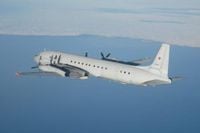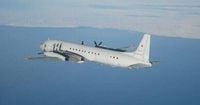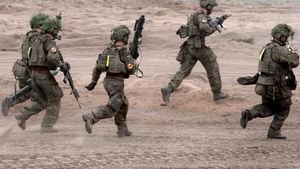On the morning of September 21, 2025, the skies above the Baltic Sea became the latest stage for a high-stakes game of military brinkmanship between Russia and NATO. German and Swedish fighter jets were scrambled to intercept a Russian IL-20M reconnaissance aircraft flying in international airspace, but without a flight plan or radio contact—a move that sent ripples of concern through the alliance and its neighbors.
According to the German Air Force, NATO’s quick reaction alert force at Rostock-Laage airbase received orders to investigate an unidentified aircraft that had appeared on radar over the South Baltic Sea. Two German Eurofighter jets took off, quickly closing in on the target. Once visually identified as a Russian IL-20M, or ‘Coot-A’ as NATO calls it, the German jets escorted the aircraft until two Swedish JAS 39 Gripen fighters arrived to assume monitoring duties. The German jets then returned to base, leaving their Swedish counterparts to continue the shadowing operation in international airspace. The incident concluded without confrontation or mishap, but the message was clear: NATO was alert and ready to respond.
Both the Swedish and German air forces confirmed that the Russian plane had not filed a flight plan and was not responding to repeated radio calls. The Swedish Air Force posted on X (formerly Twitter), “Today, JAS 39 Gripens and German Eurofighters were scrambled over the South Baltic Sea, identifying and monitoring a Russian IL-20 reconnaissance aircraft in international airspace.” German officials echoed this account, emphasizing that their jets had visually identified the aircraft before handing over responsibility to their Swedish NATO partners.
The Russian IL-20M, a Cold War-era aircraft, is no ordinary plane. Outfitted with advanced radar, signals intelligence, and electronic warfare systems, it is designed to gather electronic signals and imagery intelligence—critical tools for Moscow’s strategic surveillance operations. As reported by NPR and other outlets, the IL-20M’s presence so close to NATO airspace was interpreted as a deliberate test of the alliance’s eastern defenses, a pattern that has become increasingly frequent in recent months.
This latest encounter came just two days after a more brazen incident: On September 19, three Russian MiG-31 fighter jets crossed into Estonian airspace over the Gulf of Finland, remaining for 12 minutes before departing. Estonia, a NATO and European Union member, did not take the incursion lightly. The Estonian Foreign Ministry condemned the breach and summoned Moscow’s chargé d’affaires in protest. Tallinn also took the rare step of invoking NATO’s Article 4, which allows member states to request consultations when they feel their security is under threat. It was the first time in 34 years of Estonia’s United Nations membership that it had called for an emergency Security Council meeting in response to a military incident.
Estonian Defense Minister Hanno Pevkur minced no words when speaking to the public broadcaster ERR: “This is exactly what Russia wants — to divert our attention away from helping Ukraine, and to focus on our own backyard. That has been one of Russia’s strategic aims: To get the West to mind its own business while Russia deals with Ukraine. That is a key goal behind these kinds of provocations.”
The pattern of airspace violations isn’t limited to Estonia. According to Reuters and other sources, Poland reported that more than a dozen Russian drones entered its airspace on September 10, prompting the Polish Air Force to shoot down some of them. Prime Minister Donald Tusk described the event as “the closest we have been to open conflict since World War II.” Just days later, on September 14, Romania scrambled F-16s after detecting a Russian drone breaching its airspace during a strike on Ukraine. Russia, for its part, has denied all allegations of airspace violations, with its Ministry of Defense dismissing some of the incidents as “provocations” by Ukraine or the West.
Latvia and Lithuania have also experienced similar provocations. In July 2025, Lithuanian officials detected two Gerbera drones crossing from Belarus, one carrying explosives. Remains of a similar drone were discovered on the Baltic coast of Latvia in mid-September. These repeated incursions have led to heightened alertness and the launch of NATO’s Eastern Sentry mission, aimed at bolstering the alliance’s eastern flank and deterring further Russian military adventurism.
The response from the United States has been closely watched in the region. When asked about the incidents, President Donald Trump told reporters, “Well, I don’t love it. I don’t love it when that happens. Could be big trouble.” In a separate comment to Lithuania’s national broadcaster, Trump assured that the U.S. would protect Poland and the Baltic states if Russian aggression escalated. These remarks, while somewhat cautious, were interpreted as a reaffirmation of America’s commitment to its NATO allies.
For Estonia and its Baltic neighbors, the stakes could not be higher. Since 2014, Estonia has reported over 40 Russian airspace violations, with four such breaches occurring in 2025 alone, according to Linas Kojala of the Eastern Europe Studies Centre. Each incident, whether it involves fighter jets or drones, is seen as part of a broader Russian campaign to probe NATO’s readiness and resolve. Latvian President Edgars Rinkēvičs warned that such provocations risk “serious conflict,” a sentiment echoed by defense officials across the region.
Meanwhile, Russia continues to deny any wrongdoing. Moscow insists that its aircraft operate strictly within international law and accuses NATO of overreacting. But for many in the Baltic states and beyond, the evidence suggests otherwise. As Estonian Foreign Minister Margus Tsahkna put it, these actions are “part of a broader pattern of escalation by Russia, both regionally and globally.”
The events of September 2025 have laid bare the precarious balance of power along NATO’s eastern frontier. With Russian reconnaissance planes, fighter jets, and drones repeatedly testing the boundaries, and NATO allies responding with rapid deployments and diplomatic protests, the risk of miscalculation looms large. Whether these provocations are intended to distract the West from Ukraine, as some officials believe, or simply to assert Russian power, the result is the same: a region on edge, watching the skies, and waiting for what might come next.
As the Baltic Sea incident fades from the headlines, the underlying tensions remain unresolved. The alliance’s ability to respond swiftly and in coordination has been demonstrated, but the question of how far Russia is willing to push—and how NATO will ultimately respond—continues to hang in the air.





